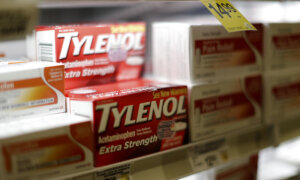Children make up around 25 percent of annual emergency department (ED) visits, but only one in five EDs across the United States are ready to handle pediatric cases, according to a new study.
Researchers estimated that more than a quarter of child deaths could be prevented if all EDs in the United States were pediatric-ready.
They also found that the cost of achieving and maintaining a high level of readiness—which means EDs have doctors and nurses trained in pediatric care, have protocols for treating children, and have medication and equipment for children of all ages and sizes—would cost up to $11.84 per child.
“Less than 20 percent of emergency departments across the U.S. are fully ready to care for children. So ... in the context of pediatric emergency care in the country, it means that we have a lot of work to do,” Dr. Craig Newgard, lead author and director of the Center for Policy and Research in Emergency Medicine at Oregon Health & Science University, told The Epoch Times in an interview.
Newgard said that the study aimed to make the benefits of improving pediatric readiness more concrete and relatable for each state by providing state-by-state estimates of annual costs. It also showed what each state and hospital could gain—specifically, how many lives could be saved—if they invested more in pediatric readiness.
Pediatric Readiness More Effective Than Vaccines
The
study, published in JAMA Network Open on Nov. 1, analyzed data from over 4,800 EDs across all 50 states and the District of Columbia to estimate the cost for all EDs to be able to care for children and to assess the potential number of lives saved.
Only around 17 percent of EDs across the United States were prepared for pediatric emergencies.
The analysis included newborns to children aged 17 who were treated at EDs. Researchers found that every year, EDs receive 669,000 “at-risk” children. These at-risk children are those who need to be transferred to another hospital or die in emergency rooms. These children can do worse or better depending on how well-staffed and equipped the EDs are.
The researchers estimated that at current readiness levels, about 7,600 at-risk children, or about 1 percent, will die during their ED visit.
But if all EDs achieved high readiness, 2,100 lives, or more than a quarter, can be saved.
The estimated cost to reach this level of readiness nationwide is $207 million. However, it varies significantly by state—from $0 in Delaware (which already meets high-readiness standards) to over $18 million in Texas.
Most children in need of emergency care are treated in EDs that handle only a few pediatric cases each day. These general EDs are usually unequipped to address pediatric emergencies.
Dr. Jared Ross, an experienced emergency physician who was not part of the study, explained, “Due to the consolidation of pediatric specialty services combined with aggressive marketing by children’s hospitals, many parents prefer that their children be seen at these facilities, even when it is not medically necessary.” This may reduce pediatric patient volumes in community and rural hospitals, giving them less reason and fewer resources to maintain pediatric readiness.
Additionally, with lower reimbursement rates for pediatric care and fewer diagnostic procedures for children, many smaller hospitals have closed pediatric units in favor of higher-revenue areas like cardiology and oncology. This has made critically ill pediatric cases in EDs much rarer, resulting in less experience and reduced comfort for physicians and nurses in treating them.
“There is a modestly higher cost of delivering care in high readiness EDs and the hospital costs needed to reach and sustain high ED readiness,” the researchers wrote in the study. Nevertheless, they found that investing in pediatric emergency units is more cost-effective than other pediatric interventions, including routine vaccinations.
“I think in terms of costs and effort, it’s definitely very feasible for even a small, relatively under-resourced hospital to reach a high level of readiness,” said Newgard.
Studies show that these at-risk children are more likely to experience better outcomes if they receive care in an ED that is well-prepared for pediatric emergencies.
Benefits and Barriers of a Pediatric-Ready ED
Increasing an ED’s readiness to care for children can significantly improve survival rates for pediatric patients.
A 2021 study by the same authors that examined records of over 370,000 injured children cared for in 832 EDs across the country found that injured children treated in high-readiness EDs had lower mortality than those treated in low-readiness EDs.
EDs have a narrow window to act, as a significant portion of children who visit die within about three hours. Having EDs prepared to treat children rather than transferring them to specialized pediatric centers could result in over 30 minutes lost—time critical for treatment.
If small EDs in rural areas became pediatric-ready, they could provide the same level of high-quality emergency care as large tertiary hospitals and reduce the burden in larger hospitals, according to the researchers.
This preparedness would also enhance the emergency care system’s capacity to respond to crises that strain resources, including pandemics, natural disasters, and mass casualty incidents such as school shootings.
Newgard said that one of the biggest barriers is lack of awareness, and the first step EDs could take is recognizing the route they must take to get there.
He explains that there are six domains of pediatric readiness, including categories such as personnel, competencies, and safety and quality improvement. Among these, he identifies care coordination as the most critical.
This requires doctors and nurses to become pediatric emergency care coordinators and take on additional part-time duties to implement policies, safety programs, and quality improvement related to ED pediatric readiness.
“When we look at the overall costs, over 95 percent of the costs are in person-time,” he explained, noting that people often assume reaching pediatric readiness would be costly due to the need for new supplies and equipment. However, most general EDs already stock over 90 percent of the required equipment, so the primary expense lies in personnel time.
Newgard believes that beyond understanding readiness, “the single biggest barrier is in hiring for those part-time positions so that you have some boots-on-the-ground people who are actually going to do the work to implement ... each of those processes and, therefore, raise the level of readiness.”
Readiness Is Highly Achievable: Experts
The concept of “readiness” is independent of a hospital’s size, resources, type, or services offered, Newgard explained. This means that even small hospitals—such as those with limited beds in rural areas and without specialized pediatric units—can achieve the same level of preparedness as large children’s hospitals in urban settings.
To make this readiness effective, both community practices and hospital culture play a role. “Parents must be willing to seek care in community hospital settings and have their children admitted there rather than be transferred. Hospitals must maintain pediatric in-patient units to drive and sustain a culture of pediatric readiness,” said Ross.
Encouraging parents to seek care in community hospitals and have their children admitted there could increase pediatric experience and improve readiness in these local facilities.
Hospitals interested in improving their pediatric readiness can get started using free resources from a national program called the Emergency Medical Services (EMS) for Children Program, which spent years developing comprehensive toolkits, checklists, and step-by-step guides to help hospitals increase their readiness.
These resources enable hospitals to begin right away, even on a limited budget, without the need for new infrastructure or additional space, said Newgard.
He also offered some strategies to help motivate EDs to achieve high readiness:
- Set Standards for Pediatric Readiness: Organizations responsible for setting quality standards in hospitals should require emergency departments to meet specific pediatric readiness standards. Medicare and Medicaid could also support this, making pediatric readiness a requirement for hospitals to receive funding.
- Secure Financial Support for Hospitals: This would entail giving hospitals extra funding if they meet pediatric readiness goals, helping cover the costs of readiness improvements. States could also set up local funding programs if communities prioritize this.
- Enact Policies That Prioritize Pediatric Care: State and federal policies could promote pediatric readiness by recognizing hospitals that meet these standards. Making pediatric readiness a policy priority would send a strong message to hospitals about its importance in saving children’s lives, according to Newgard.













